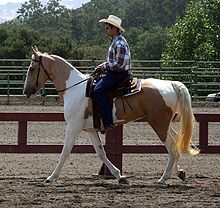
Horses can use various gaits during locomotion across solid ground, either naturally or as a result of specialized training by humans.

The Mangalarga Marchador is a Brazilian breed of riding horse. It is the national horse breed of Brazil, where there are more than half a million of them; it is among the most numerous breeds of riding horse in the world. It derives from cross-breeding of Portuguese Alter Real horses with local Criollo stock. It displays four gaits: the walk, the canter, and two ambling gaits, the marcha batida and the marcha picada; it does not trot.

The American Saddlebred is a horse breed from the United States. This breed is referred to as the "Horse America Made". Descended from riding-type horses bred at the time of the American Revolution, the American Saddlebred includes the Narragansett Pacer, Canadian Pacer, Morgan and Thoroughbred among its ancestors. Developed into its modern type in Kentucky, it was once known as the "Kentucky Saddler", and used extensively as an officer's mount in the American Civil War. In 1891, a breed registry was formed in the United States. Throughout the 20th century, the breed's popularity continued to grow in the United States, and exports began to South Africa and Great Britain. Since the formation of the US registry, almost 250,000 American Saddlebreds have been registered, and can now be found around the world, with separate breed registries established in Great Britain, Australia, continental Europe, and southern Africa.

The Tennessee Walking Horse is a breed of gaited horse known for its unique four-beat running-walk and flashy movement. It is a popular riding horse due to its calm disposition, smooth gaits and sure-footedness. The Tennessee Walking Horse is often seen in the show ring, but is also popular as a pleasure and trail riding horse using both English and Western equipment. The Tennessee Walking Horse is also seen in movies, television shows and other performances.
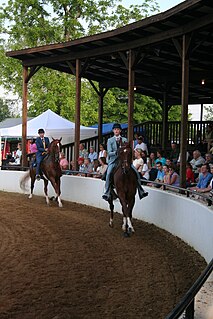
"English pleasure" is the generic term for a number of different English riding classes seen at horse shows in the United States, where the horse is ridden in either hunt seat or saddle seat tack.

The Missouri Fox Trotter is a horse breed that originated in the state of Missouri in the United States. It was developed in the Ozark Mountains by settlers in the early 19th century, and quickly developed into a gaited breed appreciated for its stock horse abilities, stamina and smooth gaits. It performs an ambling gait known as the "fox trot", a four-beat broken diagonal gait in which the front foot of the diagonal pair lands before the hind, eliminating the moment of suspension and increasing smoothness. The main breed registry was begun in 1948 and as of 2012 registers almost 100,000 horses. A European registry was begun in 1992, and as of 2009 recognizes around 600 Fox Trotters living in Europe. In 2006, a smaller registry, focused on the preservation of the original, historic type, was begun in the United States. The Fox Trotter is a mid-sized, muscular breed, used mainly for trail riding and ranch work.
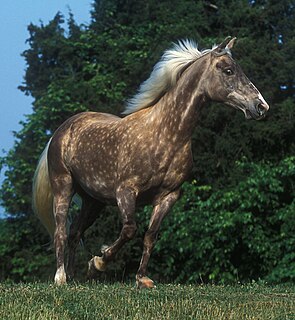
The Rocky Mountain Horse is a horse breed developed in the state of Kentucky in the United States. Despite its name, it originated not in the Rocky Mountains, but instead in the Appalachian Mountains. A foundation stallion, brought from the western United States to eastern Kentucky around 1890, began the Rocky Mountain type in the late 19th century. In the mid-20th century, a stallion named Old Tobe, owned by a prominent breeder, was used to develop the modern type; today most Rocky Mountain Horses trace back to this stallion. In 1986, the Rocky Mountain Horse Association was formed and by 2005 has registered over 12,000 horses. The breed is known for its preferred "chocolate" coat color and flaxen mane and tail, the result of the relatively rare silver dapple gene acting on a black coat, seen in much of the population. It also exhibits a four-beat ambling gait known as the "single-foot". Originally developed as a multi-purpose riding, driving and light draft horse, today it is used mainly for trail riding and working cattle.
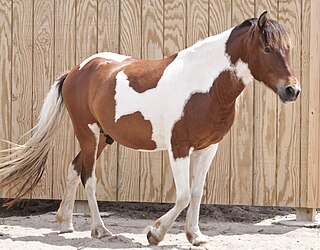
A pinto horse has a coat color that consists of large patches of white and any other color. The distinction between "pinto" and "solid" can be tenuous, as so-called "solid" horses frequently have areas of white hair. Various cultures throughout history appear to have selectively bred for pinto patterns.
The Walkaloosa is a horse breed that performs an intermediate ambling gait besides the trot. Simply stated, they are a gaited horse with Appaloosa patterning.

An ambling gait or amble is any of several four-beat intermediate horse gaits, all of which are faster than a walk but usually slower than a canter and always slower than a gallop. Horses that amble are sometimes referred to as "gaited", particularly in the United States. Ambling gaits are smoother for a rider than either the two-beat trot or pace and most can be sustained for relatively long periods, making them particularly desirable for trail riding and other tasks where a rider must spend long periods in the saddle. Historically, horses able to amble were highly desired for riding long distances on poor roads. Once roads improved and carriage travel became popular, their use declined in Europe but continued in popularity in the Americas, particularly in areas where plantation agriculture was practiced and the inspection of fields and crops necessitated long daily rides.
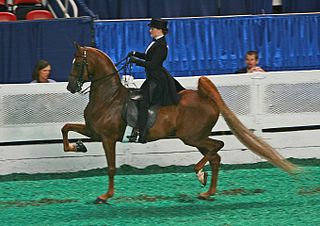
Saddle seat is a style of horse riding within the category of English riding that is designed to show off the high action of certain horse breeds. The style developed into its modern form in the United States, and is also seen in Canada and South Africa. To a much lesser extent, it is ridden with American horse breeds in Europe and Australia. The breeds used for this flashy style are typically the showy Morgan Horse, and the high stepping American Saddlebred.
The Racking Horse is a horse breed derived from the Tennessee Walking Horse, recognized by the USDA in 1971. It is known for a distinctive singlefoot gait. In 1971, the Racking Horse Breeders' Association of America, headquartered in Decatur, Alabama, was formed as the breed registry. Its goal is to preserve the breed in a natural state with little or no artificial devices that enhance gait. The horse's tail is naturally raised without nicking or tail sets. Some classes allow special shoes that enhance action, and a relatively newer class allows the use of chains, six ounces and under as action devices. The practice of soring, illegal under the Horse Protection Act of 1970, is also seen within the Racking Horse world. Since the breed's inception, about 80,000 Racking Horses have been registered, with the largest populations located in the US states of Alabama and Tennessee.
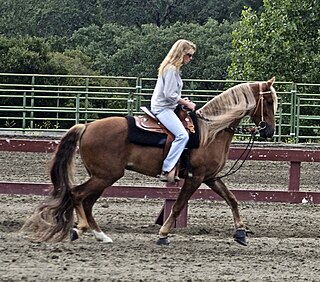
The Kentucky Mountain Saddle Horse is a horse breed from the U.S. state of Kentucky. Developed as an all-around farm and riding horse in eastern Kentucky, it is related to the Tennessee Walking Horse and other gaited breeds. In 1989 the Kentucky Mountain Saddle Horse Association (KMSHA) was formed, and in 2002, the subsidiary Spotted Mountain Horse Association (SMHA) was developed to register Kentucky Mountain Saddle Horses with excessive white markings and pinto patterns. Conformation standards are the same for the two groups of horses, with the main difference being the color requirements. The KMSHA studbook is now closed to horses from unregistered parents, although it cross-registers with several other registries, while the SMHA studbook remains open.
The American Paint Horse Association (APHA) is a breed registry for the American Paint Horse. It is currently headquartered in Fort Worth, Texas. It was founded in 1965 with the merging of two different color breed registries that had been formed to register pinto-colored horses of Quarter Horse bloodlines. One of these organizations was the American Paint Quarter Horse Association and the other was the American Paint Stock Horse Association.
The Pinto Horse Association of America (PtHA) registers horses, utility horses, ponies and miniature horses of various pedigrees with certain kinds of pinto coat colors. The word pinto is Spanish for "paint." In general terms, pinto can apply to any horse marked with unpigmented pink-skinned, white-haired areas on its coat. The Pinto Horse Association of America provides the owners and riders of pintos with a show circuit and a breed organization. The primary requirement for PtHA registration is coat color; the pinto is not a true breed, but a color breed.
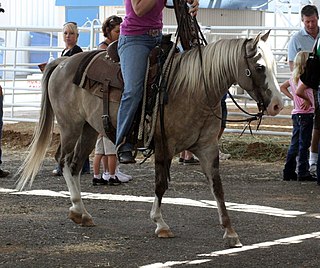
The Quarter Pony is a breed of pony that is similar to the American Quarter Horse. It stands up to 14.2 hands high and was developed from American Quarter Horse foundation bloodstock. The breed was originally developed from Quarter Horses that did not meet the American Quarter Horse Association's height requirement. It is bred to look like a small Quarter Horse, although the various registries also allow crosses with other breeds, including Paint horse, Appaloosa and Pony of the Americas, all stock types. There are three registries for the Quarter Pony, all with slightly different registration requirements. The first registry was begun in 1964, and two more were started in the 1970s. The breed is used today in a variety of Western riding disciplines.
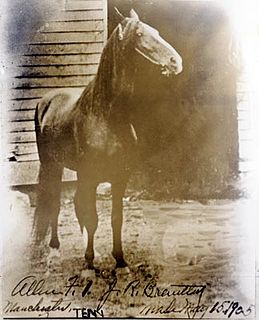
Black Allan or Allan F-1 was the foundation sire of the Tennessee Walking Horse. He was out of a Morgan mare named Maggie Marshall and by Allendorf, a stallion descended from Narragansett Pacer, Canadian Pacer, and Gaited Spanish Mustang imported from Texas. Black Allan was registered as No. 7623 by the American Trotting Registry. Although Black Allan was supposed to be a trotter, he preferred to pace and so never raced. Besides the pace, he performed a lateral ambling gait now known as the running walk. He was a black stallion standing 15 hands, 5 feet high. He was given the designation Allan F-1 when the Tennessee Walking Horse Breeders' Association, precursor to the Tennessee Walking Horse Breeders' and Exhibitors' Association, was formed in 1935. He had multiple owners throughout his life, but his last owners, James Brantley and Albert Dement, were the only ones to recognize Black Allan's use as a breeding stallion. Black Allan sired 111 known foals in his lifetime, among them Roan Allen, registration number F-38, Hunters Allen F-10, and Merry Legs F-4. Black Allan died September 16, 1910, at the age of 29.

The Mountain Pleasure Horse is a breed of gaited horse that was developed in the Appalachian Mountains of Eastern Kentucky. This breed reflects the primitive Appalachian gaited horse type and genetic testing shows them to share ancestry with earlier breeds developed in the region, including the American Saddlebred, the Tennessee Walking Horse and the Rocky Mountain Horse. Some Mountain Pleasure Horse bloodlines are traceable for over 180 years.
The Tennessee Walking Horse Breeders' and Exhibitors' Association is the oldest breed association for the Tennessee Walking Horse. It was founded in 1935 and is headquartered in Lewisburg, Tennessee. The association also runs the Tennessee Walking Horse Hall of Fame.
The Spotted Saddle Horse Breeders' and Exhibitors' Association (SSHBEA) is an equestrian organization for the registration and promotion of the Spotted Saddle Horse breed. The SSHBEA is headquartered in Shelbyville, Tennessee.
